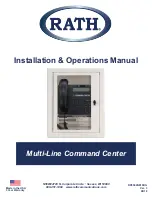
C H A P T E R
2-1
Cisco Unified Wireless IP Phone 7921G Administration Guide for Cisco Unified Communications Manager Release 7.0
OL-15985-01
2
Overview of the VoIP Wireless Network
This chapter provides an overview of the interaction between the Cisco Unified Wireless
IP Phone 7921G and other key components of a VoIP network in a WLAN environment. It contains the
following sections:
•
Understanding the Wireless LAN, page 2-1
•
Understanding WLAN Standards and Technologies, page 2-3
•
Components of the VoIP Wireless Network, page 2-7
•
Security for Voice Communications in WLANs, page 2-14
•
VoIP WLAN Configuration, page 2-18
•
Site Survey Verification, page 2-20
Understanding the Wireless LAN
With the introduction of wireless communication, wireless IP phones can provide voice communication
within the corporate wireless local area network (WLAN). The Cisco Unified Wireless IP Phone 7921G
depends upon and interacts with wireless APs (APs) and key Cisco IP telephony components, including
Cisco Unified Communications Manager, to provide wireless voice communication.
In a traditional LAN, IP phones and computers use cables to transmit messages and data packets. Cisco
Unified WLAN delivers security, scalability, reliability, ease of deployment, and management similar
to wired LANs. It includes RF capabilities that enable real-time access to core business applications and
provides proven enterprise-class secure connectivity. The WLAN is an integrated end-to-end solution
that uses wireless IP phones and APs, network infrastructure, network management, and mobility
services.
Figure 2-1
shows a typical WLAN topology that enables the wireless transmission of voice for wireless
IP telephony.
















































